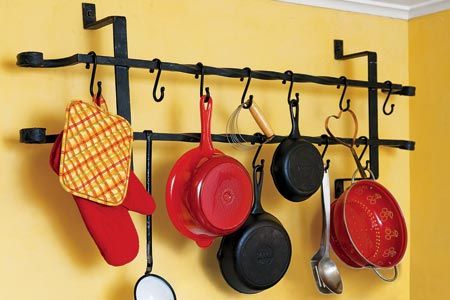We may be compensated if you purchase through links on our website. Our team is committed to delivering honest, objective, and independent reviews on home products and services.
Project details
Skill
Cost
Estimated Time
Transforming a vintage window guard into a stylish and functional pot rack is an innovative way to add character and storage to your kitchen. This DIY project allows you to repurpose a piece of architectural history while providing a practical option for organizing your cookware. With a few simple steps, you can create a unique pot rack that frees up valuable cabinet space. Plus, this project exemplifies how creativity and sustainability can go hand in hand in home improvement projects.
Step 1: Obtain Iron Window Guards for Your Pot Rack
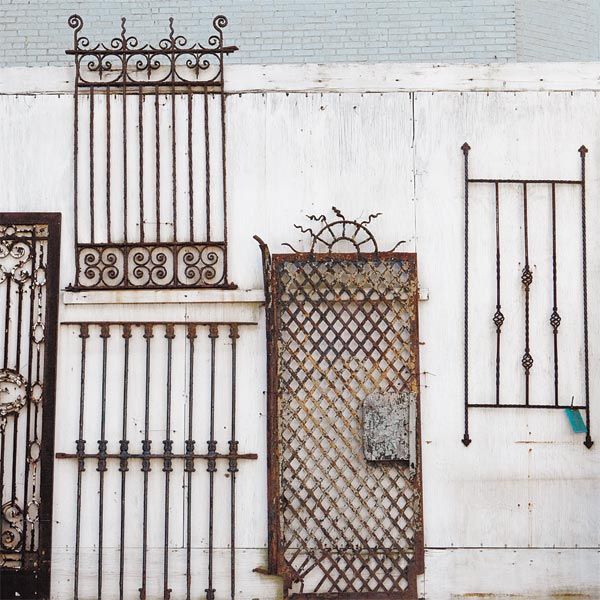
Iron window guards, once a common sight on urban buildings, have become sought-after items for their durability and timeless appeal. The designs of these ornate metalwork pieces range from simple to intricate. They add a touch of historical charm while serving a modern functional purpose.
While high-end antique guards can fetch prices up to $3,000, more affordable options are available for budget-conscious DIY enthusiasts. A simple 3-foot-tall wrought-iron guard with two widely spaced twisted rails was sourced for this project from Pasadena Architectural Salvage for $90. When selecting your window guard, consider the following factors:
- Condition: Look for guards in good condition to minimize restoration work.
- Style: Choose a design that complements your kitchen’s aesthetic.
- Size: Ensure the guard fits the intended wall space and can accommodate your cookware collection.
You’ll want to position your pot rack within arm’s reach of the stove for easy access to your cooking essentials. This placement enhances functionality and creates a visually appealing focal point in your kitchen.
Step 2: Protect the Iron Surface of the Window Guard
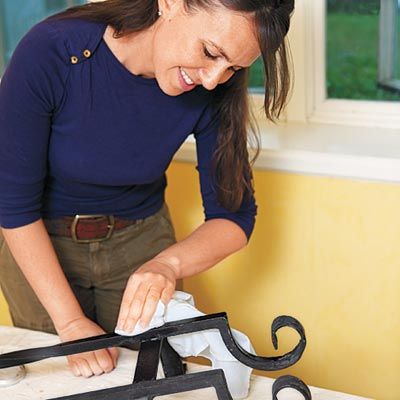
Before installing your new pot rack, protect the iron surface from rust and wear. This step preserves the guard’s appearance and extends its lifespan. Here’s how to prepare the surface:
- Clean the guard thoroughly with a mild detergent and warm water to remove any dirt or grime.
- Dry the guard completely to prevent rusting.
- Apply a metal polish, such as Renaissance Wax, to the entire surface. This product creates a protective barrier against moisture and oxidation.
- Use a soft cloth to buff the wax into a gentle sheen.
By taking these preventative measures, you’ll ensure that your pot rack remains an attractive and durable addition to your kitchen.
Step 3: Prep the Fasteners of the Pot Rack
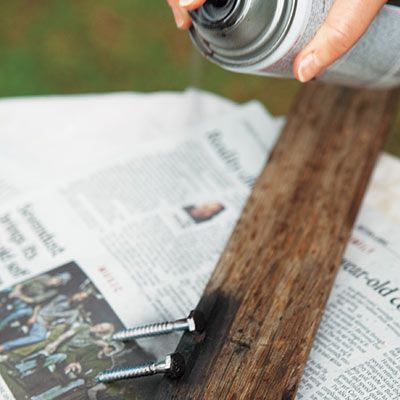
To create a cohesive look, match the color of your fasteners to the iron guard. Here’s how to prepare your fasteners:
- Choose fasteners that can handle the weight of your cookware and the type of wall you’re mounting it to.
- Clean the fasteners with a degreasing agent to ensure proper paint adhesion.
- Apply a metal primer designed for use on hardware to create a smooth base for the paint.
- Spray the fasteners with a black paint formulated for metal, such as Rustoleum American Accents.
- Allow the paint to dry completely before handling or installation.
This simple process will help your fasteners blend seamlessly with the iron guard, creating a polished and professional appearance for your DIY pot rack.
Step 4: Determine the Location for the Pot Rack
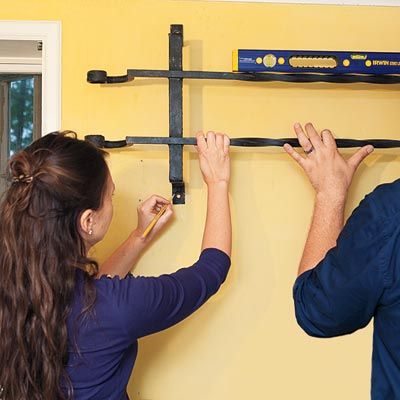
Place your pot rack in an area that allows for easy access to your cookware to make meal preparation more convenient. Follow these steps to determine an ideal location:
- Hold the rack against the wall where you plan to install it.
- Use a stud finder to locate wall studs for secure anchoring. Mark these locations lightly with a pencil.
- Place a level on top of the rack to ensure it’s perfectly horizontal.
- Mark the center of the rack’s existing holes with a pencil, making sure they align with the studs wherever possible.
If you can’t align all holes with studs, use wall anchors for added support. The extra reinforcement will allow the pot rack to handle the weight of your cookware. Your pot rack will be bearing significant weight, so safety and accessibility should be your top priorities.
Step 5: Drill Pilot Holes for Your Pot Rack
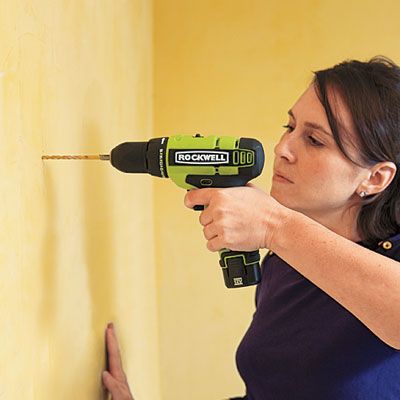
Drilling pilot holes allows for easier insertion of fasteners and securely sets the pot rack into the wall. Here’s how to prepare your pot rack for mounting:
- Wear safety glasses and use caution when operating power tools.
- Select a drill bit slightly smaller than your chosen fasteners to create pilot holes.
- Carefully drill at each marked location, ensuring you maintain a straight angle.
- If using wall anchors, insert them into the pilot holes now.
- Add washers to the lag bolts if the bolt heads are smaller than the rack’s holes for better distribution of weight.
For this project, 1½-inch-long ¼-inch lag bolts with plastic anchors were used for drywall installation.
Step 6: Steady the Rack
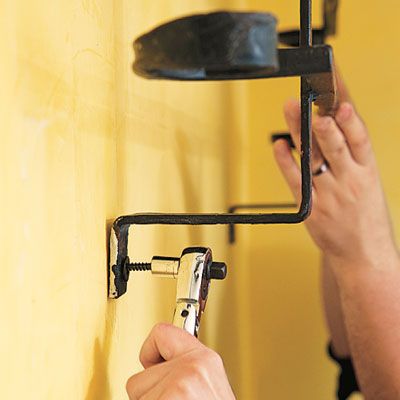
With your pilot holes drilled and fasteners prepared, it’s time to mount your pot rack. Here’s how:
- Position the rack against the wall, aligning it with the pilot holes.
- Have a friend hold the rack steady while you begin fastening.
- Start by inserting all lag bolts loosely into place. This allows for minor adjustments before final tightening.
- Use a level to check the rack’s alignment again.
- Once satisfied with the position, use a ratchet wrench to tighten each bolt securely.
- Double-check the level and adjust if necessary by slightly loosening and retightening bolts.
Take your time with this step to keep your pot rack perfectly positioned and level.
Step 7: Arrange the S-Hooks
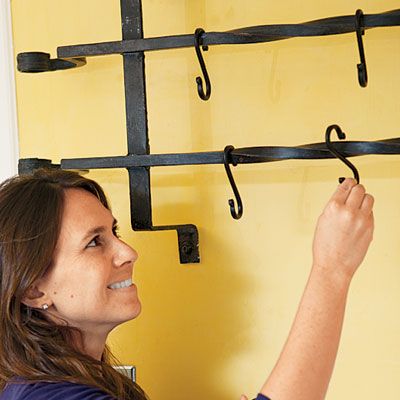
The final step in creating your vintage window guard pot rack is arranging the S-hooks to display your cookware. Follow these tips for optimal arrangement:
- Choose S-hooks that complement the style of your iron guard and are strong enough to support your cookware.
- Distribute hooks evenly along the top and bottom rails of the rack. For a 3-foot rack, 10 hooks provide a good balance.
- Consider the size and weight of your pots and pans when placing hooks. Heavier items should be hung from the sturdier top rail.
- Arrange your cookware by size or frequency of use for visual appeal and practicality.
- Don’t overcrowd the rack. Leave some space between items for easy access and a cleaner look.
The beauty of this DIY project is its flexibility. You can easily adjust the arrangement of your cookware as your needs change or your collection grows. Experiment with different layouts to find the most functional and visually pleasing configuration. Transforming a vintage window guard into a pot rack is a creative and practical way to add character to your kitchen while improving storage.
Tools
 Level
Level Ratchet wrench
Ratchet wrench Drill/driver
Drill/driver Pencil
Pencil
